Google’s November 2021 core update hit fast and hard; here is what the data providers saw
The results from this data showed that this rollout hit hard within the first 24 hours of the announcement and then slowed fast.
On November 17, 2021, Google began rolling out the November 2021 core update, this came about four and a half months after the July 2021 core update, which was a month or so after the June 2021 core update. So, we had a total of three broad Google core updates in 2021.
We asked several data companies that track Google’s search results to send us impressions of this update. The results from this data showed that this rollout hit hard within the first 24 hours of the announcement and then slowed fast. Keep in mind, Google has not confirmed that this update is done rolling out yet. Most reports show that there are signs that the November 2021 update was more substantial than the July 2021 update.
Data providers on the November 2021 core update:
Semrush. Semrush data showed that the November 2021 core update hit hard and then slowed very quickly in terms of its volatility tracker, as shown below (or you can view live at the Semrush Sensor tool).
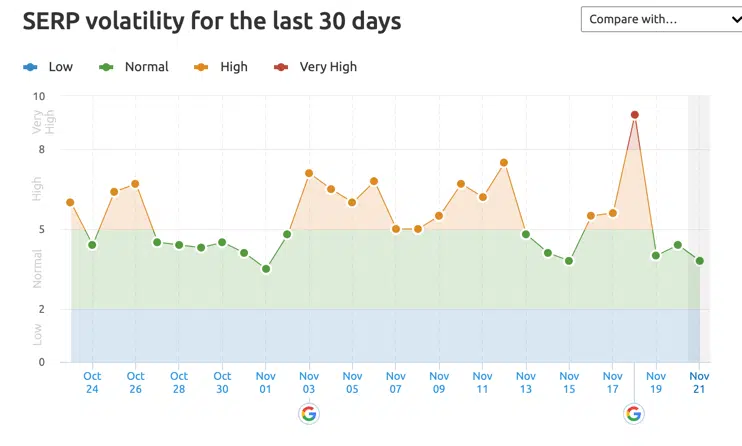
“This is similar to how the July update rolled out but the return to ‘normal’ levels of fluctuations was even more dramatic here (i.e., less of a ‘slow down’ period compared even to July),” Mordy Oberstein from Semrush told us.
The November update was “far more volatile” than what we saw back in the July core update, the company told us. Specifically, the November update was 12% more volatile than July core update on the desktop search results and 23% more volatile on mobile search results. So when digging into this update, make sure to check your mobile results, not just your desktop results.
Here is a chart plotting the difference between the November and July 2021 core updates by sector:
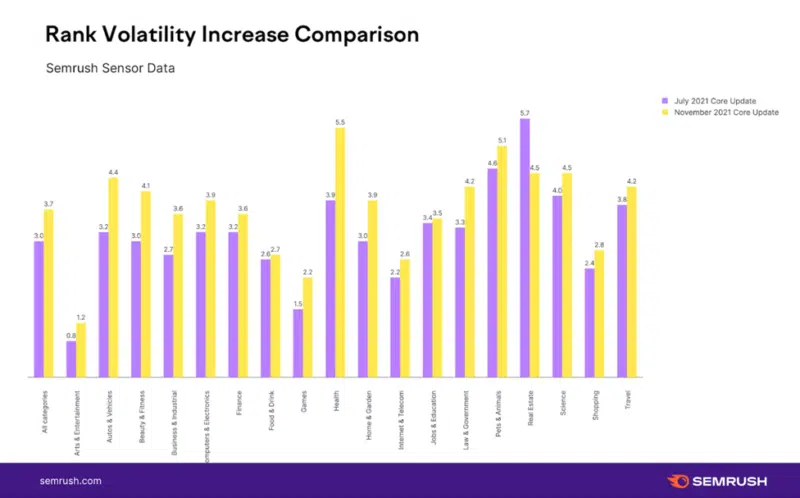
The health sector saw 41% more volatility on both desktop and mobile in the November 2021 core update than it did back in the July 2021 core update. The health sector is often more impacted by core updates than other sectors.
Even more so, 16% of the top 20 results were not listed in the Google Search results prior to the November update. Meaning, 16% of the ranking URLs between positions 1-20 ranked worse than position 20 prior to the update, Semrush said.
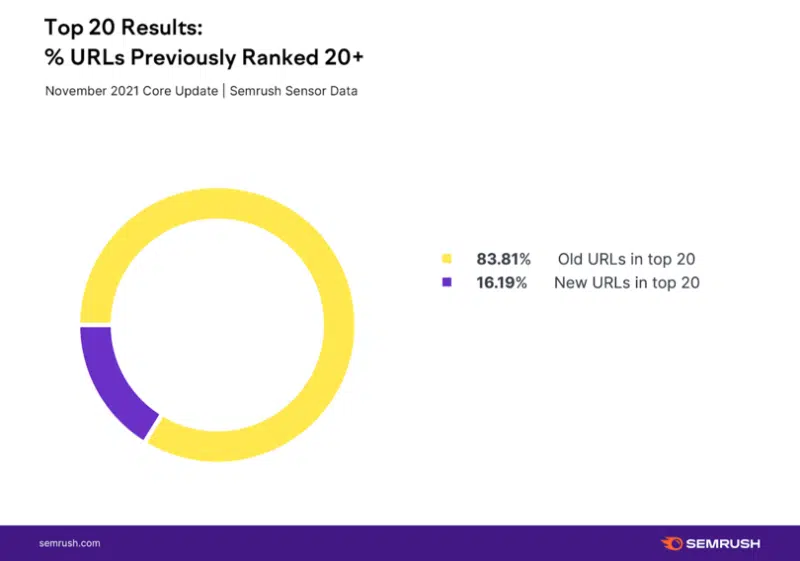
And here is a chart of the winners and losers from this November 2021 core update from Semrush:

RankRanger. The RankRanger team also analyzed the Google search results after this November core update rollout. They also found that this update rolled out pretty quickly, although it may not be done yet. “This update shows similar levels of fluctuations to the July Core update,” RankRanger’s Shay Harel said. But, he said this is when you look at the top three and top ten results — the top five results, however, showed substantially higher fluctuations, Harel told us. RankRanger also noticed that, with regard to the average changes in the top 20 positions, the company saw slightly lower levels than the July core update.
The chart below shows the changes based on top 3, top 5 and top 10 results:
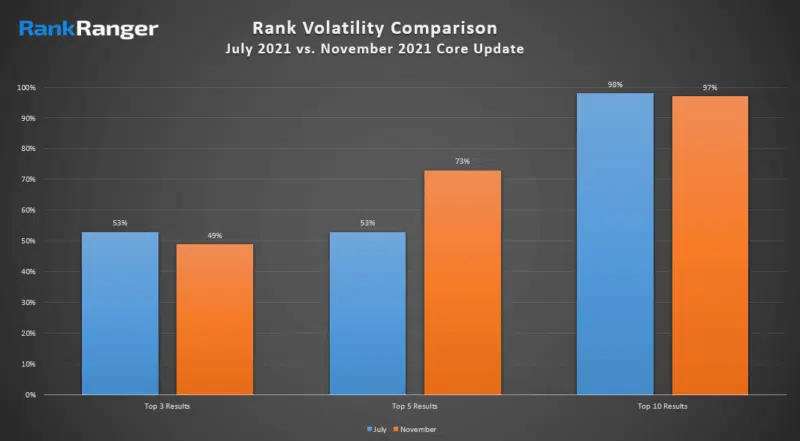
Also, if you look at the health, finance, retail and travel niches, RankRanger is showing fairly even fluctuations, with the exception of the retail niche. It seems retail saw greater fluctuations in the top three and top five positions, the company told me. Here is a chart that shows that:
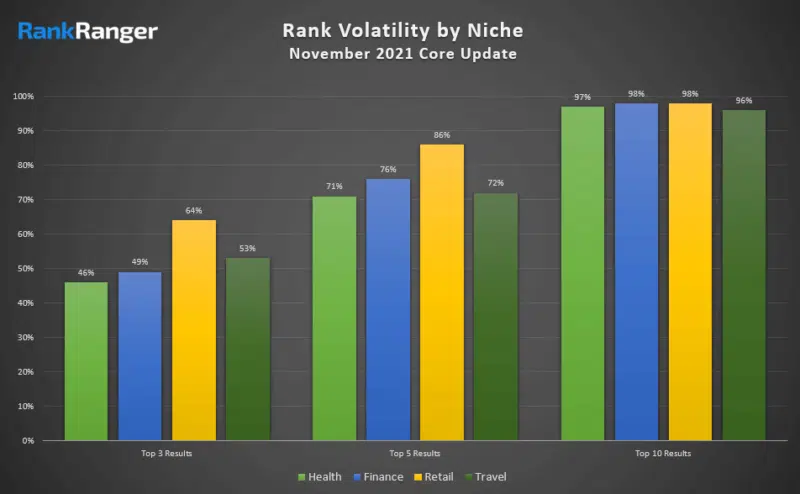
SISTRIX. The folks at SISTRIX, another data provider that tracks the changes in the Google search results, sent their top 20 winners and losers for the November 2021 core update.

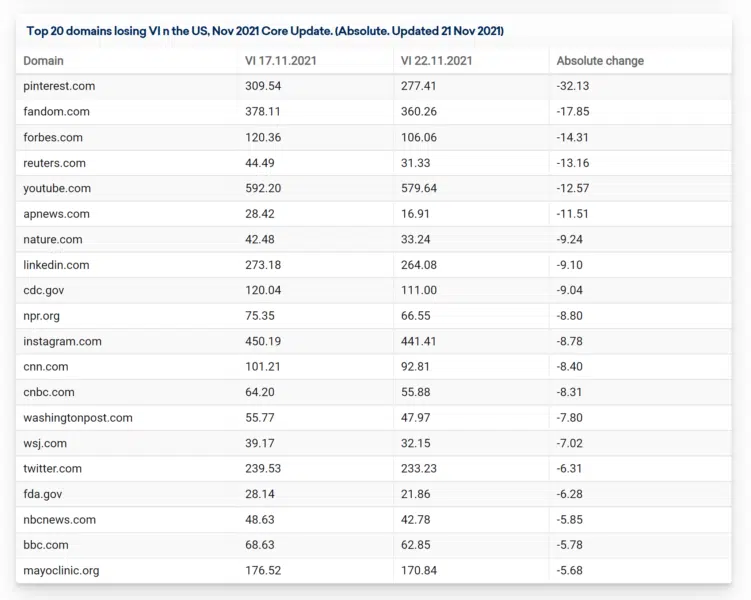
Here is a chart comparing some of the websites competing in the dictionary space. It seems like these four really saw some big gains with this update:
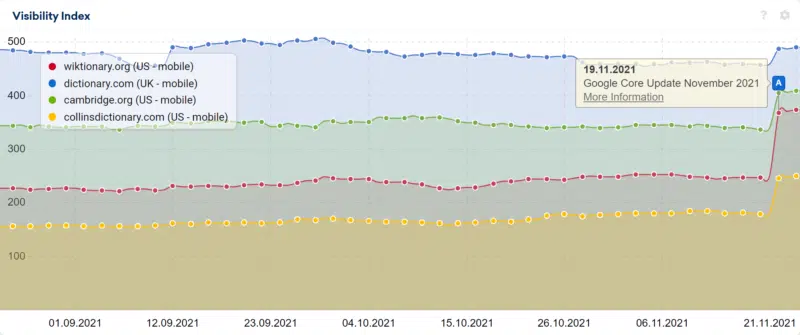
seoClarity. Mitul Gandhi from seoClarity told us that there is a “large amount of fluctuation lasting a few days,” which he said is common with most Google core updates. The seoClarity team shared some of the biggest changes they saw across some big brands.
For example, in the e-commerce niche, Wayfair and eBay stood out to seoClarity as having significant drops, with the initial data from November 16th compared to November 18th. But there was a bounce-back shortly after for some reason with Wayfair and eBay. Here is a chart of Wayfair’s search visibility:

Walmart and HomeDepot have seen their keywords in top three positions in Google Search increase by 10% and 19% respectively, “boding well for their holiday season,” Mitul Gandhi said. Bed Bath and Beyond saw a 45% jump in their top three positions in Google Search. But those top retailers selling footwear saw a drop, specifically Zappos lost 23% of their top 3 rankings while DSW lost 25%.
In other areas outside of e-commerce, Booking.com saw the strongest improvements in rankings in the seoClairty data set. Between 11/16 and 11/21 they are ranking for around 18,000 more keywords in the top three positions in Google Search. Whereas Skyscanner was the notable decline in travel, losing 23% of their keywords in the top 3 positions. SnagaJob.com seems to have lost 60% of their top 3 rankings while SimplyHired.com lost 19%. Car and Driver lost 11% of its keywords in the top 3 positions. And, Pinterest lost 13% of its top 3 rankings, while Etsy gained 19% in the top 3 positions.
“Don’t panic! Initial fluctuations are not where many will end up as Wayfair and Ebay have shown,” Gandhi advised, He also shared some early data on Twitter this past Friday, but the data above is fresher from its data set.
More on the November 2021 core update
The SEO community. The November 2021 core update, like I said above, was felt fast and hard. Not just in terms of the ranking impact but the timing. I was able to cover the community reaction in one blog post on the Search Engine Roundtable. It includes some of the early chatter, ranking charts and social shares from some SEOs.
What to do if you are hit. Google has given advice on what to consider if you are negatively impacted by a core update in the past. There aren’t specific actions to take to recover, and in fact, a negative rankings impact may not signal anything is wrong with your pages. However, Google has offered a list of questions to consider if your site is hit by a core update. Google did say you can see a bit of a recovery between core updates but the biggest change you would see would be after another core update.
Why we care. It is often hard to isolate what you need to do to reverse any algorithmic hit your site may have seen. When it comes to Google core updates, it is even harder to do so. What this data and previous experience and advice has shown us is that these core updates are broad, wide and cover a lot of overall quality issues. The data above has reinforced this to be true. So, if your site was hit by a core update, it is often recommended to step back from it all, take a wider view of your overall website and see what you can do to improve the site overall.
We hope you, your company and your clients did well with this update.
More on Google updates
Other Google updates this year. This year we had a number of confirmed updates from Google and many that were not confirmed . In the most recent order, we had: The July 2021 core update, Google MUM rolled out in June for COVID names and was lightly expanded for some features in September (but MUM is unrelated to core updates). Then, the June 28 spam update, the June 23rd spam update, the Google page experience update, the Google predator algorithm update, the June 2021 core update, the July 2021 core update, the July link spam update, and the November spam update rounded ou the confirmed updates.
Previous core updates. The most recent previous core update was the July 2021 core update which was quick to roll out (kind of like this one) followed by the June 2021 core update and that update was slow to roll out but a big one. Then we had the December 2020 core update and the December update was very big, bigger than the May 2020 core update, and that update was also big and broad and took a couple of weeks to fully roll out. Before that was the January 2020 core update, we had some analysis on that update over here. The one prior to that was the September 2019 core update. That update felt weaker to many SEOs and webmasters, as many said it didn’t have as big of an impact as previous core updates. Google also released an update in November, but that one was specific to local rankings. You can read more about past Google updates over here.
Search Engine Land is owned by Semrush. We remain committed to providing high-quality coverage of marketing topics. Unless otherwise noted, this page’s content was written by either an employee or a paid contractor of Semrush Inc.


